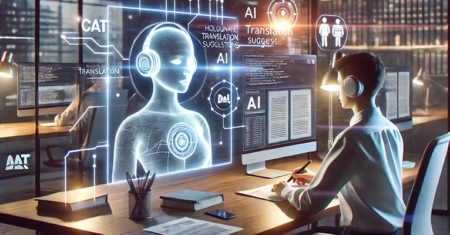Optimizing Large Language Models (LLMs): Methods and Best Practices
Optimizing the output quality of Large Language Models (LLMs) is crucial to ensure consistent, reliable, and accurate results across various applications. There are three main methods for optimizing LLMs: Prompt Design, Retrieval-Augmented Generation (RAG), and Fine-Tuning. Each approach has specific strengths, limitations, and suitable use cases. In the following, we explore each method and discuss combined approaches for specialized translation tasks, particularly for adhering to specific terminology and corporate language.

Prompt Design: Quick and Cost-Effective Optimization
Prompt Design, also known as Prompt Engineering, is the simplest method for improving LLM results. It relies on precise formulation of input prompts to guide the model’s responses. This method is ideal for simple to moderately complex tasks that don’t require in-depth model adjustments.
Benefits
- Quick Implementation: Adjustments can be easily tested and refined without modifying the model itself.
- Cost-Effective: No additional data or model adjustment resources are needed.
- Flexible: Prompt design can be adapted to a wide variety of tasks.
Techniques in Prompt Design
- Clear and Precise Instructions: Well-defined instructions can direct the model in the right direction.
- Breaking Down Tasks: Dividing complex tasks into simpler prompts can enhance control.
- Systematic Testing: Regular prompt evaluation and refinement help to achieve the best results.
Limitations
Prompt design reaches its limits when dealing with more complex or highly domain-specific tasks. Without specific knowledge, the model may lack the necessary depth and accuracy.
Retrieval-Augmented Generation (RAG): Context and External Data Integration
Retrieval-Augmented Generation (RAG) incorporates external data sources into model responses. This is useful when current, domain-specific, or proprietary information is needed, which is not included in the model’s training data.
Benefits
- Expanding Model Knowledge: By accessing external knowledge bases, the LLM can retrieve contextually relevant information.
- Reducing Hallucinations: Providing external factual knowledge minimizes the likelihood of incorrect or unreliable responses.
- Flexibility: The knowledge base can be easily updated without requiring a complete model retraining.
RAG Applications
RAG is particularly helpful when the model needs to access up-to-date or specific information. For targeted translations with proprietary terminology, for instance, RAG can pull company-specific terms from a knowledge base, ensuring accurate and consistent language use.
Limitations
RAG’s dependence on external data sources may impact model speed, and it’s not always suited to broad topics, as the data basis must be focused on the application’s needs.
Fine-Tuning: Customization for Specialized Tasks
Fine-Tuning is the most resource-intensive method, as it requires targeted retraining of the model. It is particularly suitable for highly specialized use cases where the desired output must follow a specific style or structure.
Benefits
- Domain-Specific Customization: Fine-tuning allows the model to learn knowledge and skills for specific applications.
- Control Over Tone and Style: Fine-tuning can train the model to maintain a desired tone or writing style.
- Improved Accuracy on Complex Tasks: By tailoring the model to specific requirements, fine-tuning enhances accuracy for specialized tasks.
Fine-Tuning Applications
Fine-tuning is valuable for tasks that demand high consistency in tone and format, such as corporate-specific translations, technical documentation, or legal texts. For example, fine-tuning is useful when the model must be trained on specific linguistic conventions or terminology.
Limitations
Fine-tuning can be time-consuming and costly, and too narrow a focus on specific data may lead to overfitting, limiting flexibility and adaptability.
Combined Approaches: The Right Method for Complex Translation Tasks
For complex tasks requiring accuracy, domain-specific knowledge, and adaptability, combining methods (e.g., RAG and Fine-Tuning) often yields the best results. This is especially relevant in targeted translations with proprietary language and terminology.
Scenario: Targeted Translations Using Proprietary Language
For generating translations that adhere to set terminology and corporate language, RAG proves particularly useful. Using a knowledge base containing company-specific terms and preferred translation examples allows the LLM to produce translations aligned with corporate language standards. The knowledge base is also easily adjusted and extended, making RAG more flexible than Fine-Tuning.
- Building a Proprietary Knowledge Base: Collect and structure glossaries, example texts, and relevant translations.
- Retrieval Process: During translation requests, the model searches the knowledge base for relevant terms and context information.
- Model Generation: The LLM generates translations that are both accurate in content and aligned with company-specific language.
Comparison: Fine-Tuning vs. RAG for Proprietary Translations
While Fine-Tuning is effective in adapting an LLM to a specific style or linguistic conventions, RAG has several key advantages for translation tasks:
- Quick Adjustments: The knowledge base can be updated as needed without requiring a new fine-tuning process.
- High Consistency: A RAG architecture ensures consistent use of terminology and style across all translations.
- Cost and Time Efficiency: Unlike fine-tuning, RAG doesn’t incur high retraining costs or delays.
Conclusion: Selecting the Optimal Method for Your Use Case
Choosing the best optimization method depends on the application’s requirements and available resources:
- Prompt Design is ideal for quick, cost-effective improvements.
- RAG offers an efficient solution for tasks requiring current or specific context, such as translations with proprietary terminology.
- Fine-Tuning is particularly useful when specialized, consistent outputs in specific formats or styles are required.
Carefully selecting and combining these optimization methods allows companies to leverage LLM technology for high-quality, precise, and scalable outcomes.
FAQ
A current knowledge base is essential to provide accurate and relevant answers in a RAG system. The key steps are as follows:
- Automated Data Synchronization: Configure the RAG system to check for data changes regularly and to update automatically. Setting update intervals ensures the latest documents and terms are stored in the knowledge base.
- Using APIs: APIs can directly connect external data sources, like databases or content management systems, to the RAG system, making real-time data integration possible. APIs reduce manual updates and make the knowledge base more dynamic.
- Versioning and Data Archiving: Versioning tools help maintain different versions of documents within the system and enable quick recovery when necessary. Archiving options are also helpful for retrieving historical data when needed.
- Ongoing Evaluation and Optimization: Regularly reviewing the quality and relevance of the knowledge base helps identify outdated information that requires updating. Automated feedback mechanisms and usage analytics are helpful in this regard.
Several technical components are needed to create a RAG system that retrieves and integrates external data with an LLM:
- Knowledge or Vector Database: A vector database is needed to manage and query data in the form of embeddings. These embeddings allow the system to find similar or relevant entries based on semantic search queries. Examples include Pinecone, Weaviate, or FAISS.
- Vector Embedding Models: An embedding model converts text and other content into numerical representations that reflect semantic meaning. OpenAI, Hugging Face, and other providers offer such models that integrate well with RAG systems.
- API for Data Integration: An API connects the knowledge base with external information sources, allowing data to be automatically updated and new content added without manual intervention.
- Resources for Data Processing and Storage: The RAG system requires significant processing power to handle data and conduct vector searches. Cloud providers such as AWS, Google Cloud, and Microsoft Azure offer scalable solutions for data processing and storage.
- Question-Answering Model (LLM): Finally, an LLM such as GPT-4 is needed to generate responses. This model processes the user input along with the retrieved information from the database to produce accurate, context-based answers.
The integration and use of external data sources in a RAG system present certain legal and security challenges, particularly concerning data privacy and security:
- Data Privacy Policies and GDPR Compliance: RAG systems must ensure that all integrated data complies with GDPR, which means that personal data can only be used if there is a legal basis, and it is processed in a secure environment.
- Data Encryption: To prevent unauthorized access, all data should be encrypted during storage and transmission. Using TLS encryption and encrypted databases is standard.
- Access Restrictions and Data Sharing: Companies should ensure that only authorized users can access sensitive data within the RAG system. Access restrictions and authentication methods like multi-factor authentication help minimize unauthorized access.
- Transparency in Data Usage: For legal clarity, it should be specified how data in the knowledge base is used. This includes data protection agreements and a detailed log documenting what data is used and for what purpose.
- Compliance with Internal Security Standards: A RAG system should be implemented in line with the company’s internal security guidelines and regularly reviewed. Conducting a risk analysis and scheduling regular security audits help identify potential weaknesses.



